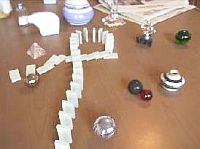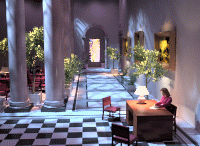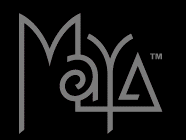Technology in Fiat Lux
| Fiat Lux was made possible by techniques in image-based modeling, rendering, and lighting presented at SIGGRAPH over the last few years. To build the 3D model of the interior of St. Peter's Basilica from the set of still photographs that we took, we used the Facade photogrammetric modeling system presented at SIGGRAPH 96, which was also the subject of Paul Debevec's Ph.D Thesis: | |
| Facade: Modeling and
Rendering Architecture from Photographs SIGGRAPH 96 Ph.D. Thesis: Modeling and Rendering Architecture from Photographs 1996 | |
| All of the digital images used in Fiat Lux were taken using a special high dynamic range photographic technique, which was used to capture the full range of lighting in each view, allowing the team to reconstruct the illumination inside the basilica. This technique, which involves combining a set of images taken at different shutter speeds into a single high dynamic range image, is described in: | |
| | Recovering High Dynamic Range
Radiance Maps from Photographs Software now available! SIGGRAPH 97 |
| The computer-generated spheres, monoliths, and pendulum in Fiat Lux were added to the captured environments using the image-based lighting techniques based on those described in: | |
| | Rendering Synthetic Objects into Real
Scenes: Bridging Traditional and Image-Based Graphics with Global Illumination and High Dynamic Range Photography SIGGRAPH 98 |
| Our first experience in combining image-based lighting techniques with dynamic animations occurred in the summer of 1998. We used Brian Mirtch and John Canny's IMPULSE dynamic simulation system to create a set of falling dominos on a kitchen table. The project was carried out by undergraduates Christine Waggoner and Son Chang. | |
 | Combining Dynamic Simulation, High Dynamic Range Photography and Global Illumination |
| We used Gregory Ward Larson's RADIANCE rendering system to perform the image-based lighting in Fiat Lux. The images were mapped as high dynamic range texture maps onto the geometry of the environments. RADIANCE, being a global illumination simulation system, fully simulated the interaction of the light, the objects, and the environments. RADIANCE is publicly available for download. Many thanks to Greg for his help in using RADIANCE to create Fiat Lux! | |
 | The RADIANCE Synthetic Imaging System |
| For most of the animation in the film, we used the dynamic simulation feature in Alias|Wavefront's Maya 1.0 modeling and animation system. The dynamic simulator written by graphics researchers David Baraff and Andy Witkin realistically simulated the effects of gravity and the collisions between the computer-animated objects and environments. Team members Christine Cheng and Jenny Huang wrote the program to convert Maya simulation data into RADIANCE model files. | |
 | Maya, Alias|Wavefront's professional modeling, animation, and rendering package. |
| Fiat Lux was rendered in approximately 72 hours of full time-computation on professor David Culler's Millennium cluster at the UC Berkeley computer science division. | |

| The UC Berkeley Millennium Project |
| Earlier versions of the technologies used to create Fiat Lux were used to create two other recent Electronic Theater animations: | |
| | The Campanile Movie SIGGRAPH 97 Electronic Theater |
|
|
Rendering with Natural Light SIGGRAPH 98 Electronic Theater |